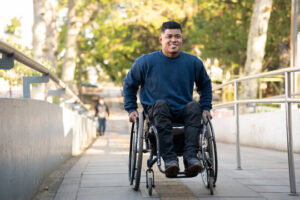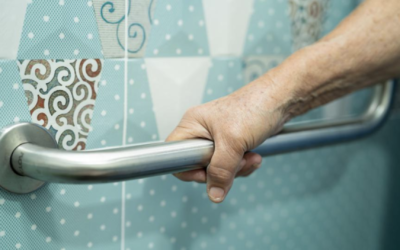Image: George H. W. Bush signing the ADA in 1990
The fight for equal rights and opportunities for people with disabilities has been a long and challenging journey. In the United States, the passing of the Americans with Disabilities Act (ADA) in 1990 marked a watershed moment, for the first time dismantling significant barriers and ensuring legal protections for people with disabilities. While the ADA was pivotal in increasing access and equality, barriers, inequity and inequality still exist. In addition, marginalization and discrimination continues to pervade our broader culture. So much progress has been made in the past 60 years, and still have work to do as we move towards true equality.
A Legacy of Segregation and Exclusion
Prior to the ADA, the lives of people with disabilities were characterized by profound marginalization. Segregated schooling, inaccessible workplaces, and a lack of public accommodations were commonplace. Helen Keller, a prominent deafblind advocate, once remarked, “[The] marvelous inventions of the age are but extensions of the senses we already possess. The deaf cannot hear the telephone’s ring, nor the blind read its message.” This stark reality highlighted the exclusion faced by People with disabilities from basic aspects of life.
Discriminatory practices not only limited opportunities but also fostered a sense of isolation. President George H.W. Bush acknowledged this, stating, “The Americans with Disabilities Act… makes freedom a reality for millions of Americans.” By signing the ADA into law, he outlawed discrimination based on disability in employment, public accommodations, transportation, communication, and government services.
Breaking Down Barriers: The Impact of the ADA
The ADA’s impact has been transformative. Architectural barriers were dismantled, replaced by ramps, accessible bathrooms, and lowered counters. Public transportation systems became more accessible, with lifts and audio announcements. Educational institutions were mandated to provide reasonable accommodations for students with disabilities. Overall, the impact fostered sweeping change in the areas of public buildings, education, and employment. These building blocks were critical for enabling people with disabilities to live independently, and make their own life choices.
Justin Dart, notable disability rights advocate, once said: “The ADA isn’t just about physical access. It’s about economic independence, social integration, and education.”
The perceivable changes in buildings and structures, as well as admissions and other policies, helped start a long and ongoing shift in the previously commonplace discriminatory and judgmental attitudes towards people with disabilities.
King Jordan, former director of the National Rehabilitation Information Center, and the first deaf president of Gallaudet University, said as much: “The ADA is more than just a law; it’s a cultural shift. It has changed the way we think about people with disabilities.”

Image: Wheelchair user on ramp
Employment Opportunities:
One of the most significant outcomes from the ADA has been the increased participation of people with disabilities in the workforce. The ADA prohibits, for the first time in history, discrimination against qualified employment candidates on the basis of disability, requires employers to offer the same benefits and training as they do to all employees, and mandates reasonable accommodations to enable people with disabilities to effectively come to work and do their jobs. This has, over time, increased employment opportunities for people with disabilities and increased diversity and inclusivity in the workplace.
Independent Living:
The ADA’s impact extends beyond access to employment opportunities. It has empowered people with disabilities to live more independently by mandating physical accessibility and accessible transportation options. Following this trend, over the years, accessibility has become more expected and commonplace, leading to increases in accessibility in technology, personal care services, housing, communications and other areas of living. These shifts, in combination with independent living services from Centers for Independent Living such as CPWD, have significantly increased the ability for people with disabilities to live independently in today’s society.
The Ongoing Struggle: Challenges and Unfinished Business
While the ADA has been a success story, challenges remain. Enforcement is not always strong enough to ensure compliance. Major violations get attention, but on a smaller or individual scale, many people with disabilities still face discrimination in the areas of access, employment and housing. In addition, the ADA primarily addresses physical and sensory disabilities, which can leave gaps in the law that affect individuals with cognitive or mental disabilities.
“We must strive to move beyond physical access and address the systemic issues that continue to marginalize people with disabilities,” said Lydia X. Z. Brown, Autistic disability rights activist and scholar.

Image: Disability Rights March
Looking Ahead: What’s Possible
Technological advancements continue to extend the boundaries of human capacity in every way. The nascent emergence of AI will change the way the world works. Similarly, current technologies, such as voice-controlled computers and hand-held devices, greatly increase the ability of certain people with disabilities to communicate, work, learn, get assistance, and more. New and innovative prosthetics and mobility devices are expanding the capacity of many people to go to work, live independently, recreate, travel, and removing other mobility barriers. In the future, brain-computer interfaces, robotics, and artificial intelligence offer exciting possibilities for greater independence, as they can the assistance and support needed to live independently. However, ensuring equitable access to these technologies is important to address. Some will be cost prohibitive, or only for the wealthy; others may take years to be covered by insurance or waivers. The ADA was signed in 1990, before we had the sophisticated technology of today. As the ripples of the ADA unfold into the 20th century, it’s important to ensure that the spirit of that Act – accessibility, equity, and equality – are woven into the technological structures and applications of the modern age.
Centers for Independent Living (CILs)
CILs like CPWD and others play a vital role in keeping this awareness and focus on accessibility and equity alive. One of our mandates is to conduct systems advocacy, which means we are cities, states, lawmakers and policy-holders to undo systems and policies that present barriers to independent living. Simultaneously, we watchdog public initiatives for equity and equality, and strive to present and champion new laws and policies that support independent living, accessibility, equity and equality for people with disabilities.
A Shared Responsibility
The pursuit of independent living for people with disabilities is a shared responsibility. Governments, policymakers, technology developers, service providers, and individuals alike all have a role to play. Education, public awareness campaigns, and fostering a culture of inclusion are vital components of this ongoing vision.
The passing of the ADA was a line in the sand where categorical and generally accepted discrimination and marginalization of people with disabilities was stopped. It’s taken time for that effort to evolve, and changes are ongoing. We need to both celebrate the progress and advancements in accessibility, equity and equality, and pay attention to the areas that still need to be remedied, improved or cultivated. We do this together – CPWD is here to not only provided independently living services, but also to actively dismantle marginalization and discrimination. And we can’t do that alone. We need your help to stand up, bring your voice, and make a difference in this area.
As Alice Wong, disability rights activist, said, “Disability justice is about dismantling the whole system of oppression that isolates and devalues people with disabilities.”
The ADA serves as a powerful cornerstone, but it is just the beginning. As Maya Angelou, poet and civil rights activist said, “Do the best you can until you know better. Then when you know better, do better.”
By acknowledging past injustices, celebrating progress, and working towards a more inclusive future, we can ensure that the promise of the ADA is fully realized.





